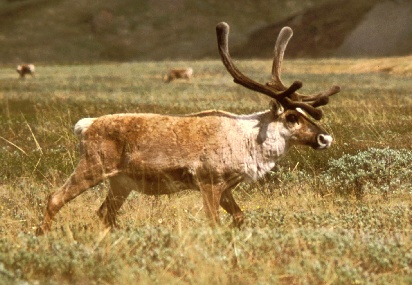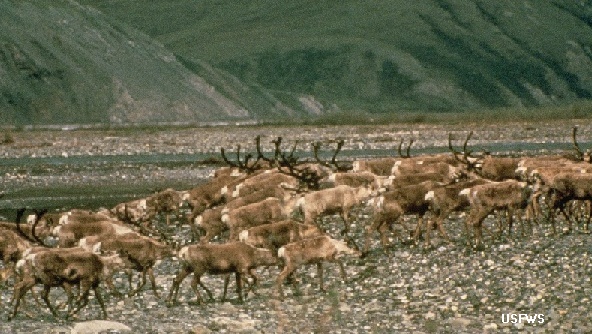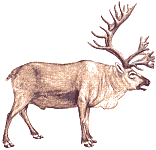BARREN-GROUND CARIBOU

image credit : Bob Stevens; US Fish and Wildlife Service; license: public domain
|
The barren-ground caribou lives in the northern forests and migrates to the tundra.
Peary caribou live on the islands in the Canada's far north.
Woodland caribou live farther south. The barren-ground caribou can be found in the Yukon, Northwest Territories and Nunavut. (map) DESCRIPTION The barren-ground caribou has a dark brown face with white around the nose. In summer the coat is light brown. In winter the coat turns a sandy-beige. There is white fur along the neck, underbelly, beneath the tail and above the hooves. The velvety antlers are dark brown. FOOD Barren-ground caribou eat grasses, mosses, sedges, willows, flowers and small arctic plants called lichens. In the winter their main source of food are ground and tree lichens. Caribou use their excellent sense of smell to find lichens under the snow. They dig the lichens out with their wide hooves.  ADAPTATIONS Caribou live in groups called herds. The caribou migrate in search of food. In the winter they live in forests on the edge of the Arctic. In spring thousands head for the tundra where the babies ( calves) are born. During the summer they eat as much as possible to prepare for the winter. Then they can live off the fat that is stored in their bodies. Caribou are able to walk in the deep snow because they have long legs and wide hooves with fur. They are strong swimmers and can cross rivers and lakes while moving from place to place. The hollow hairs of their coats act like a life jacket and help to keep the animals afloat. The hollow hairs also help to conserve body heat. The caribou grows a long thick winter coat. ENEMIES Arctic wolves eat caribou. The young or sick are the easiest to catch. If a caribou moves away from the herd the wolf pack chases it and surrounds it. A young calf must become strong so it can run and escape enemies like wolves, bears, eagles and wolverines. Caribou try to avoid swarms of biting insects in the summer. They are pestered by mosquitoes, black flies, warble flies and nose bot flies. Their constant twitching, movement and blood loss weakens the animals.
THE YOUNG  |
LINKS to caribou information -
Hinterland Who's Who |
Barren-ground caribou - Canadian Geographic
photos - US Fish and Wildlife Service, license : public domain
jgiannet@hotmail.com
Peary caribou - Canadian Geographic
| Woodland caribou - Canadian Geographic
an educators' guide from Project Caribou - Wild Caribou of North America (pdf)
2003
updated August 2011